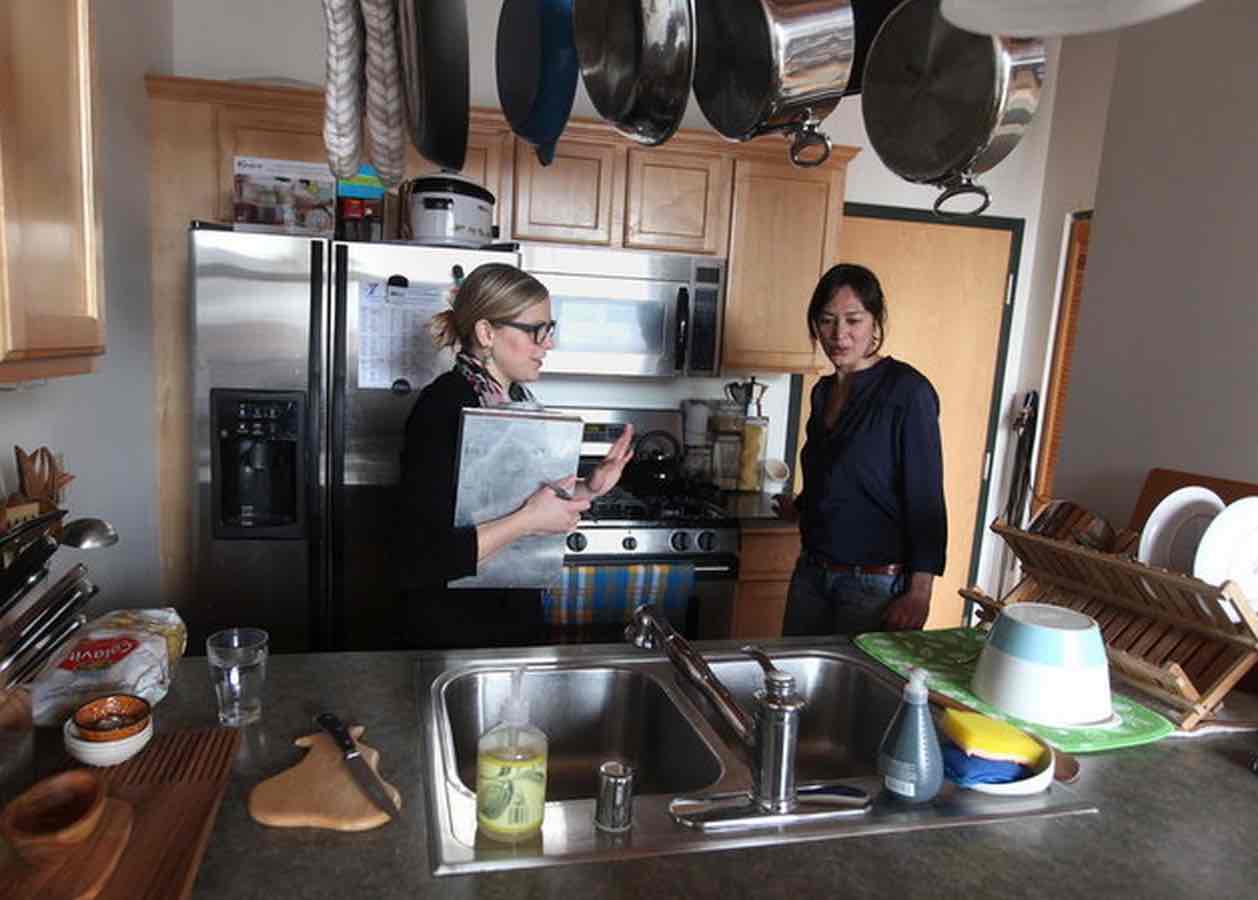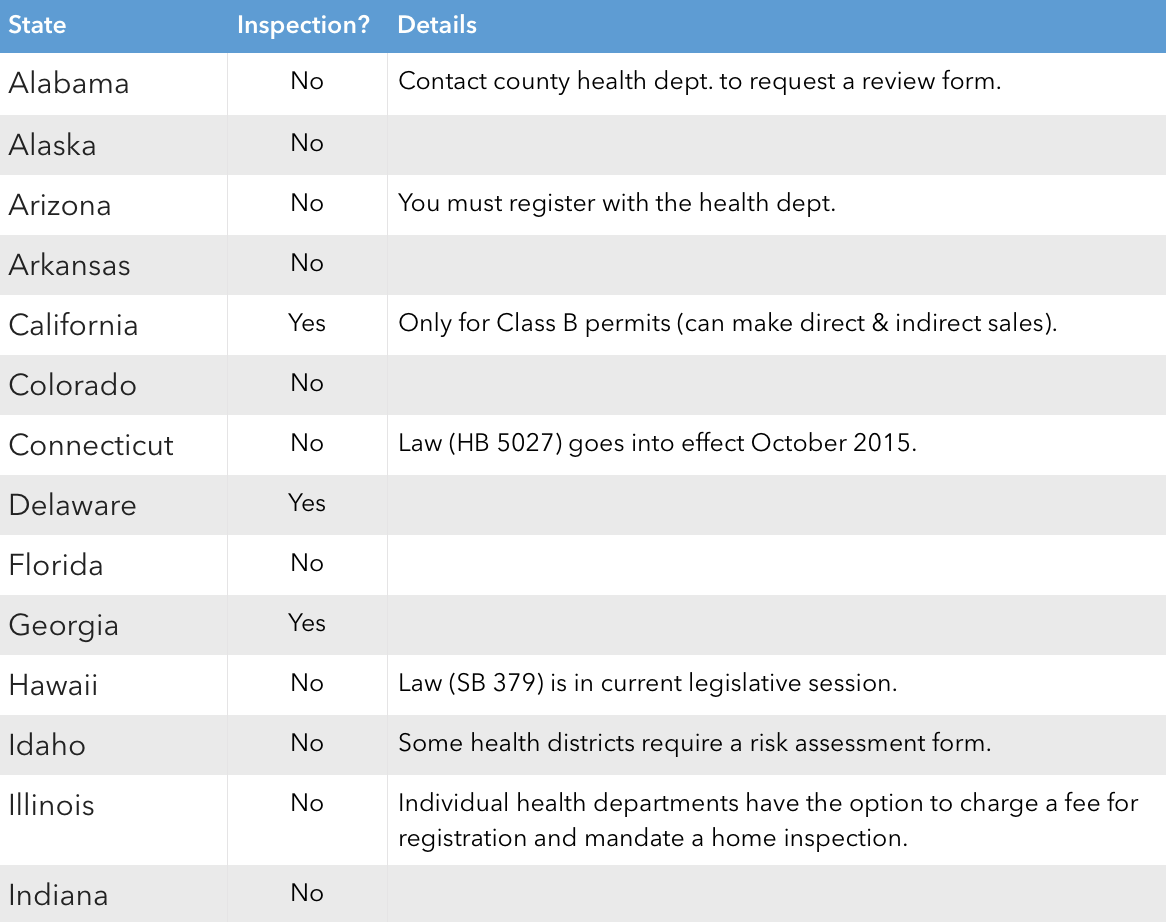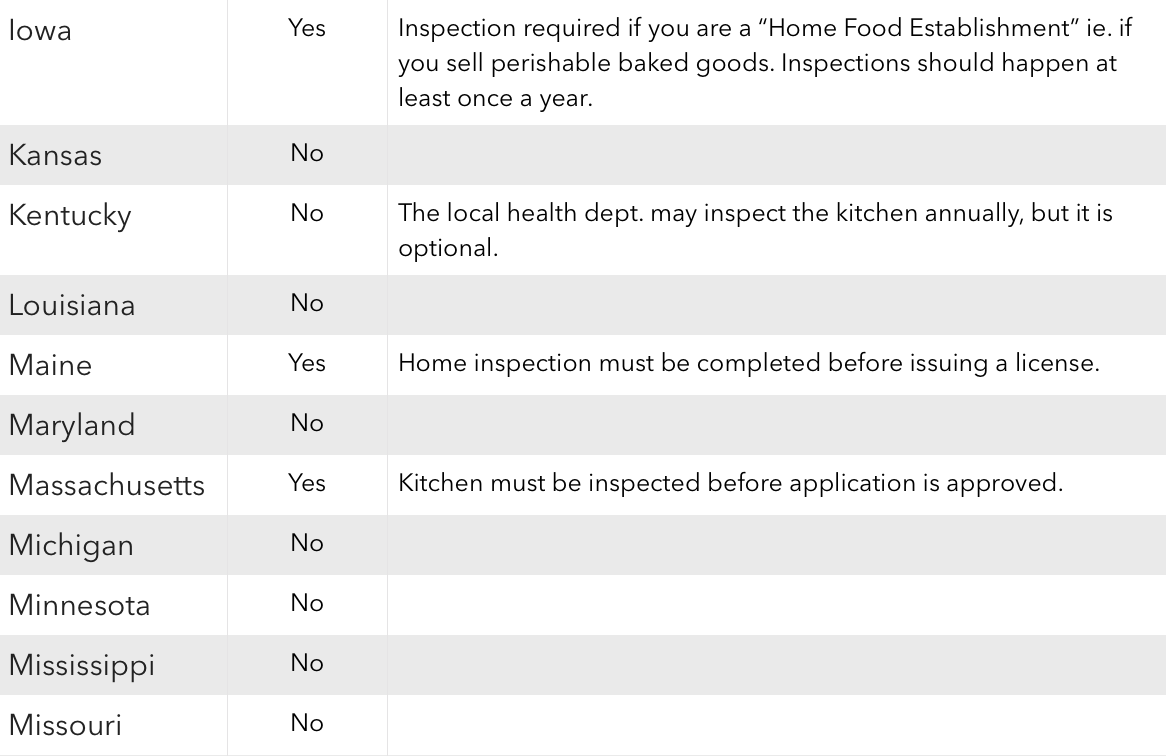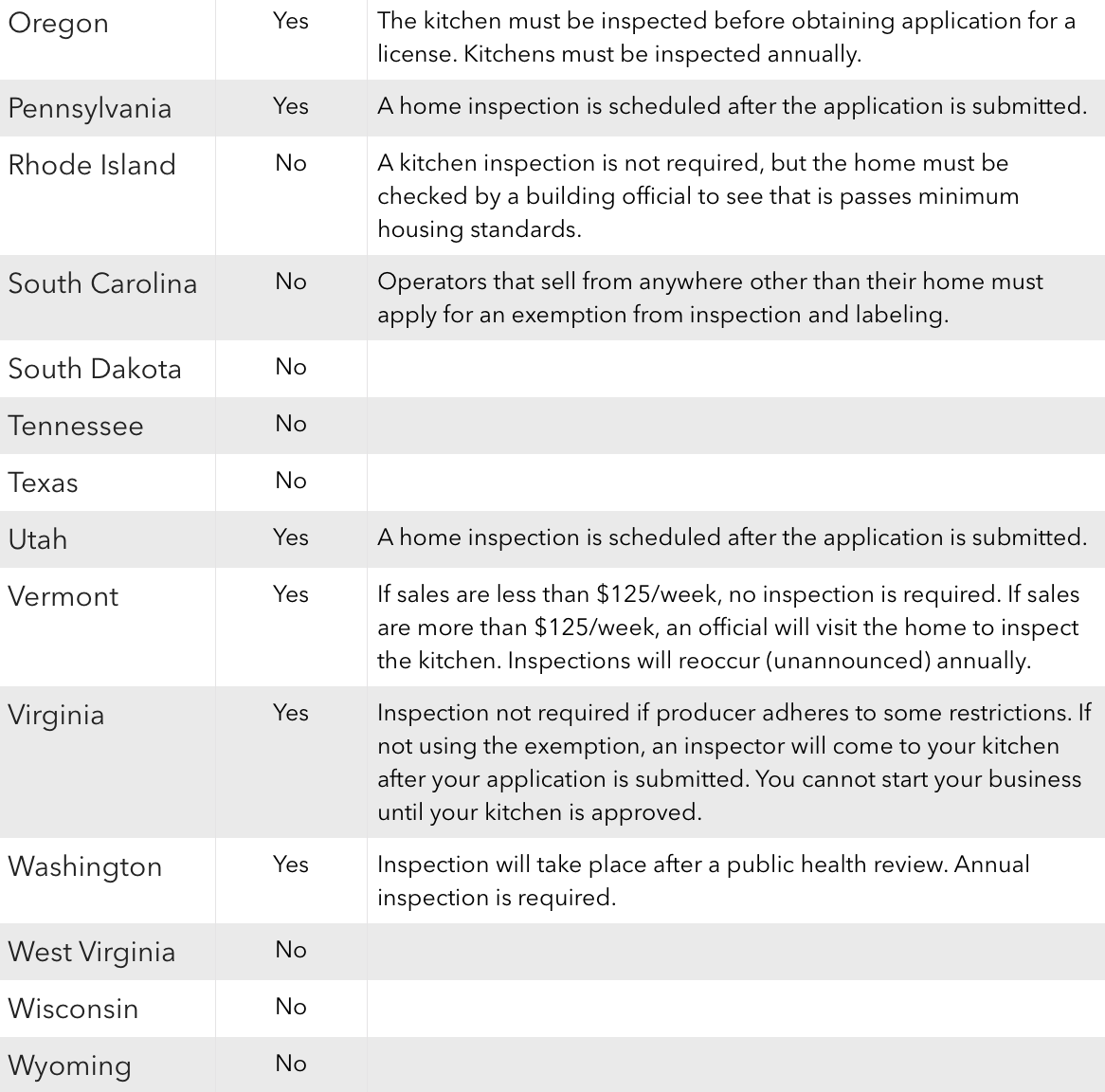Running a business out of your home kitchen is a low-risk way to enter the competitive food service industry; however, reaping the rewards of your culinary skills can have its complications.
Every state has its own regulations about what is required before a home kitchen can be used for a cottage food operation (CFO), with some states requiring you to create a business plan, enroll in food handler training classes, apply for permits and licenses, and even have a health inspector visit your kitchen!

In this guide, you’ll learn whether you’ll be subjected to a kitchen inspection, what you can expect from one, and a checklist of items to watch out for during your inspection.
Will I Need an Inspection?
Possibly. Some states require inspections by a health investigator, some states have optional inspections, and some don’t do them at all. There are a few states that only require a kitchen inspection for a CFO under certain circumstances.
Currently, there are 14 states that require home inspections for CFOs as of now: California, Delaware, Georgia, Iowa, Maine, Massachusetts, New Mexico, North Carolina, Oregon, Pennsylvania, Utah, Vermont, Virginia, and Washington.
Some states, like California and Virginia, only require an inspection for some types of CFOs. Use the table below to see more details about your state inspections:




Source: www.forager.com/laws/
What to Expect When You’re Inspected
If you’ve ever worked in a commercial kitchen, you know that health inspections can be stressful. They are usually unannounced, so you always have to be on your best behavior. When the inspector suddenly shows up, you don’t have the opportunity to scramble around and tidy everything up. Luckily, people who work out of home kitchens are at an advantage here.
You have an appointment with a health inspector, so you have time to prepare for their arrival, and your “staff” consists of you alone or you and several household members, so you have more control over the environment.
So before you let yourself get too worked up, take a deep breath. Here’s what you can expect from your inspection:
-
One of the first things you should know is that your kitchen may not be the only room inspected. Rooms used for storage of supplies and products are open to inspection. Some states will even inspect the exterior of your home to ensure that there is no way for vermin and rodents to enter your workplace. Keep this in mind as you prepare.
-
Speaking of vermin or rodents, do you have pets that come in your home at any time (even at night)? If so, will most likely not be allowed to run a CFO from your home. This may seem harsh, but think of it this way: a cat goes from the street outside to their litter box to your countertop. Who knows where else Fluffy’s paws have been? Guide dogs may be allowed, but only if you can prove that they are unlikely to result in the contamination of food.
-
Whatever you do, don’t try to obstruct the health inspector, even if you just noticed you missed something. It will irritate the inspector and you may lose points for it.
-
Don’t let the inspection distract you from what you were working on. If you were in the middle of making a cake, don’t just leave the batter sitting around while they complete the inspection. Either finish working with it, or store it appropriately. You don’t want to lose points because you were distracted! If anything in your kitchen is broken, fix it before the inspection. Even having a light bulb that is burnt out could decrease your score.
-
Having some finished product with the appropriate labels on them could be beneficial. Some states need to see that you are using the correct labels during the inspection.
-
Finally, don’t worry. If you fail your first inspection, you aren’t doomed forever. Find out where you lost points and work on improving those areas. You’ll be acing your second inspection in no time!
Checklist of Things to Watch Out For
Disease Control
- Are any of your employees (yourself included) currently ill? If so, they cannot be in the place of work.
Cleanliness
-
All employees must be wearing clothing that protects against the contamination of food.
-
All employees must maintain personal cleanliness. Nobody likes a smelly cook.
-
Hands must be washed at a hand-washing station (separate from where you wash utensils) after an absence from the work station and at any time they may have become contaminated. Did you just scratch your nose? Put your hands in your pockets? Wash them!
-
Remove any unsecured jewelry, or jewelry that is unable to be sanitized.
-
Restrain long hair. That means man-buns too!
-
Have a separate space in the work area away from where food is prepared and utensils are washed for eating food, chewing gum, smoking, or drinking beverages.
-
Depending on the state, all employees may need to complete education and training, such as a food handler’s permit. Even if this isn’t required by your state health department, you should consider it. It won’t hurt, and you’ll learn a lot of useful information!
-
You should have a system for removing waste in a way that won’t provide contamination for food; having a covered trashcan is a good idea.
-
Gloves should be used when necessary.
Workplace Design
-
You’ll need to have sufficient space for your equipment and storage. Keep it neat!
-
Floors, walls, and ceilings must be constructed in a way that they can be kept clean and in good repair. Dripping or condensation from pipes, ducts, and fixtures should not contaminate food.
-
Adequate lighting is necessary everywhere that food is kept or prepared and hands or utensils are cleaned.
-
Safety-type bulbs must be used to protect food in the instance of glass breakage. Don’t forget the lights in the hood over your stove!
-
Adequate ventilation must be used to control vapors or fumes. CO2 levels may be tested during your inspection.
General
-
Equipment must be in sanitary and working condition, so replace that old, broken meat thermometer!
-
All utensils and equipment must be cleaned in a manner that prevents contamination of food.
-
Cleaning and sanitizing materials must be both safe and adequate.
-
All food-contact surfaces (think utensils, bowls, pans, cutting boards, etc.) and non-food-contact surfaces (think cupboards, floors, walls, etc.) must be cleaned as often as necessary to prevent contamination.
-
Single-use items (including pans and serving utensils) must only be used once.
Facilities
- Your kitchen’s water supply must be sufficient and come from an adequate and potable source. Some states will test your water, some will not.
Equipment
-
Utensils are adequately cleanable and properly maintained. Do you have a wooden cutting board with lots of nicks and gouges in it? Either sand it down or buy a new one.
-
Food-contact surfaces must be corrosion-resistant and nontoxic.
-
Freezers and fridges must have working thermometers (attach them to the door, which is the warmest part) and should be at the appropriate temperatures (<45°F for fridge, below freezing for freezer).
-
Equipment must be washed between uses.
Food Storage
-
Raw materials must be kept and stored in a way to prevent contamination. Keep your meat in a separate drawer in the fridge, and make sure your storage containers are in good condition.
-
Keep your bulk food labeled, dated, and secured.
-
Frozen food must stay frozen until ready to use. When thawing food, it must be done in a way that is safe and prevents contamination.
-
Hot foods must be kept at 140°F or above. When cooling, they must be cooled in a way that effectively prevents contamination.
-
Finished food and unfinished (raw) food must be kept separated to prevent contamination
Other Questions?
If you need more information about your state’s inspection process, be sure to check the correspinfing government site:
-
California: http://www.cdph.ca.gov/programs/pages/fdbcottagefood.aspx
-
Delaware: http://dda.delaware.gov/foodprod/
-
Georgia: http://agr.georgia.gov/cottage-foods.aspx
-
Iowa: http://www.state.ia.us/government/dia/137D_2011Code.pdf
-
Maine: http://extension.umaine.edu/food-health/resources-for-small-food-businesses-in-maine/assistance/
-
Massachusetts: http://www.mass.gov/eea/agencies/agr/markets/culinary-tourism/massachusetts-food-processors-resource-manual-generic.html#ch4ResKitch
-
New Mexico: https://www.env.nm.gov/fod/Food_Program/HomeBasedFoodRegulations.html
-
North Carolina: http://www.ncagr.gov/fooddrug/food/homebiz.htm
-
Oregon: https://www.oregonlegislature.gov/bills_laws/lawsstatutes/2013ors625.html
-
Pennsylvania: http://www.legis.state.pa.us/WU01/LI/LI/CT/PDF/03/03.PDF
-
Utah: http://ag.utah.gov/cottage-food-production.html
-
Vermont: http://healthvermont.gov/enviro/food_lodge/Bakeries.aspx
-
Virginia: http://law.lis.virginia.gov/vacode/title3.2/chapter51/section3.2-5130/
-
Washington: http://agr.wa.gov/FoodAnimal/CottageFoodOperation/
